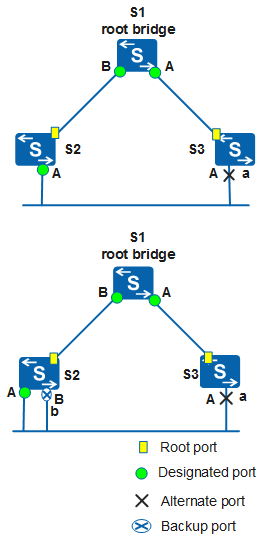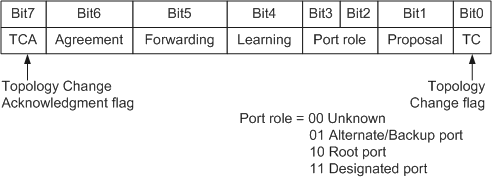RSTP Port Roles and Port States
RSTP Port Roles
Figure 1 shows the four port roles defined in RSTP: root port, designated port, alternate port, and backup port. Compared with STP, RSTP adds two port roles.
The functions of the root port and designated port are the same as those defined in STP. Table 1 shows the alternate port and backup port.
Category |
Alternate Port |
Backup Port |
|---|---|---|
From the perspective of configuration BPDU transmission |
An alternate port is blocked after learning a configuration BPDU sent from another bridge. |
An alternate port is blocked after learning a configuration BPDU sent from itself. |
From the perspective of user traffic |
An alternate port acts as a backup of the root port and provides an alternate path from the designated bridge to the root bridge. |
A backup port acts as a backup of the designated port and provides a backup path from the root bridge to the related network segment. |
After RSTP determines all port roles, the topology convergence is completed.
Due to changes in port roles compared with those in STP, RSTP uses a different configuration BPDU format. To describe port roles, RSTP uses the Flags field.
- The value of the Type field is changed from 0 to 2. Devices running STP will discard configuration BPDUs sent from devices running RSTP.
- The Flags field uses the six bits reserved in STP. This configuration BPDU is called a Rapid Spanning Tree Bridge Protocol Data Unit (RST BPDU), as shown in Figure 2.
RSTP Port States
RSTP reduces the number of port states to three. Depending on whether a port can forward user traffic and learn MAC addresses, the port will be in one of the following states:
Discarding: The port does not forward user traffic or learn MAC addresses.
Learning: The port does not forward user traffic but learns MAC addresses.
Forwarding: The port forwards user traffic and learns MAC addresses.
Table 2 compares the port states defined in STP and RSTP and port roles. Port states are not necessarily related to port roles.
STP Port State |
RSTP Port State |
Port Role |
|---|---|---|
Forwarding |
Forwarding |
Root port or designated port |
Learning |
Learning |
Root port or designated port |
Listening |
Discarding |
Root port or designated port |
Blocking |
Discarding |
Alternate port or backup port |
Disabled |
Discarding |
Disabled port |

